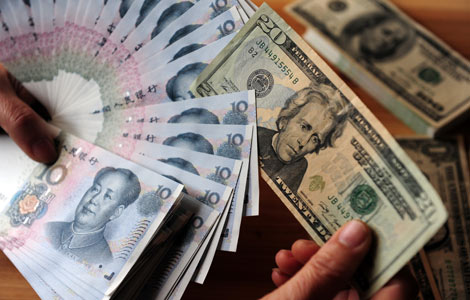Renminbi rate near 'equilibrium'
Updated: 2012-03-29 07:49
By Wei Tian (China Daily)
|
||||||||
|
 Trade statistics and the slowing growth of China's foreign exchange reserves suggest that there is no more "undervaluation" of the Chinese currency, according to a report by the Bank of China on Wednesday. [Meng Zhongde / For China Daily] |
The renminbi's exchange rate is nearing "equilibrium", a central bank researcher said on Wednesday, suggesting that the currency would be more likely to experience two-way fluctuation instead of the unilateral appreciation of previous years.
"The Chinese economy is now rebalanced both internally and externally, with a fairly small trade surplus and a relatively low inflation rate, as well as a positive real interest rate," Jin Zhongxia, director of the Financial Research Institute affiliated to the People's Bank of China, wrote in an article for the China Financial News, which is run by the central bank.
"This is a phenomenon rarely seen in the past decade," Jin said, while regarding it as evidence that the renminbi exchange rate is now close to equilibrium after years of unilateral appreciation against the greenback. According to Jin, the yuan has gained 10 to 15 percent in real terms since the second half of 2008, and more than 30 percent since China introduced exchange reforms in 2005.
In the meantime, the US dollar depreciated 15 percent from the second quarter of 2009 to the third quarter of 2010, while the euro also depreciated 8 to 10 percent in the first half of 2010, he said, adding that both currencies have remained relatively stable since then.
Premier Wen Jiabao said during the recent National People's Congress session that China will intensify its currency regime reform and allow relatively wider two-way fluctuation.
On Tuesday, the central parity rate of the yuan, a reference rate set by the central bank, registered a third consecutive day of appreciation to 6.2840 per dollar, a record high since 2005. The rate picked up from 6.3359 on March 15, its lowest point since the beginning of the year. But the rate retreated to 6.2912 on Wednesday. Analysts see the volatility of the renminbi as a result of the fluctuating US dollar, and the central bank's intention to test the market's response by broadening the range of the reference rate.
Ben Bernanke, chairman of the US Federal Reserve, said earlier this week that the US central bank would keep monetary policy accommodative in order to quicken economic growth and cut unemployment, weakening the US dollar and lifting other non-dollar currencies.
But President Hu Jintao on Tuesday told US President Barack Obama that an appreciating yuan was not a solution to the US trade deficit and unemployment, and said that China will strive to maintain the yuan exchange rate on a reasonable level by "letting the market play a greater role" and increasing the flexibility of the yuan.
The yuan is now permitted to move as much as 0.5 percent either above or below the daily reference rate. "And the range can be expanded to 0.7 percent," Wu Xiaoling, former deputy governor of the central bank, was quoted by the Oriental Morning Post as saying.
A report by the Bank of China on Wednesday said that the trade data, and the slowing growth of the foreign exchange reserve suggested there is no more "undervaluation" of the renminbi exchange rate.
But a two-way fluctuation does not necessarily mean an end to renminbi appreciation. The report said that as China's economy continues to strengthen, the yuan will still be heading toward a stronger position, only at a slower pace.
Zhao Qingming, a professor at the University of International Business and Economics, said the value of the yuan is likely to pick up by 3 to 5 percent this year, while Peng Wensheng, chief economist with China International Capital Corp, estimated the change will be within 1 percent of depreciation and 2 percent of appreciation.
weitian@chinadaily.com.cn

 Relief reaches isolated village
Relief reaches isolated village
 Rainfall poses new threats to quake-hit region
Rainfall poses new threats to quake-hit region
 Funerals begin for Boston bombing victims
Funerals begin for Boston bombing victims
 Quake takeaway from China's Air Force
Quake takeaway from China's Air Force
 Obama celebrates young inventors at science fair
Obama celebrates young inventors at science fair
 Earth Day marked around the world
Earth Day marked around the world
 Volunteer team helping students find sense of normalcy
Volunteer team helping students find sense of normalcy
 Ethnic groups quick to join rescue efforts
Ethnic groups quick to join rescue efforts
Most Viewed
Editor's Picks

|

|

|

|

|

|
Today's Top News
Health new priority for quake zone
Xi meets US top military officer
Japan's boats driven out of Diaoyu
China mulls online shopping legislation
Bird flu death toll rises to 22
Putin appoints new ambassador to China
Japanese ships blocked from Diaoyu Islands
Inspired by Guan, more Chinese pick up golf
US Weekly

|

|






